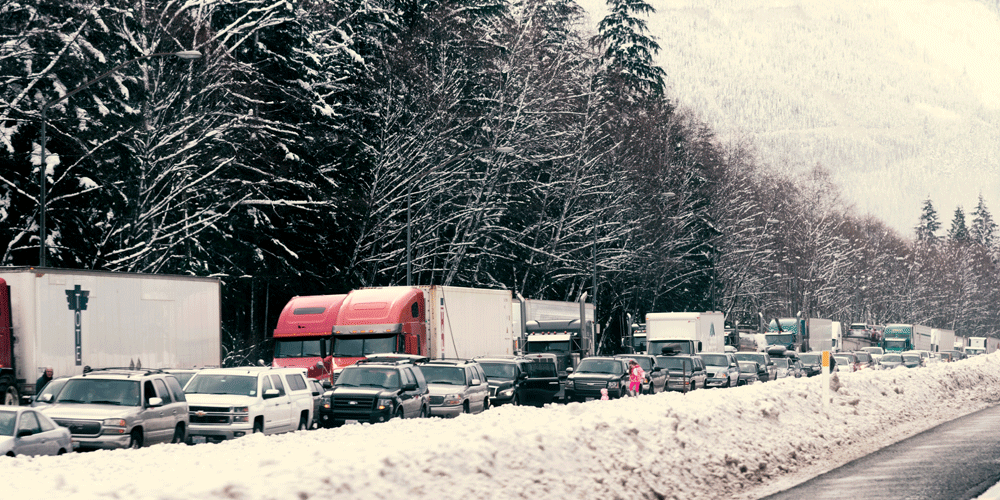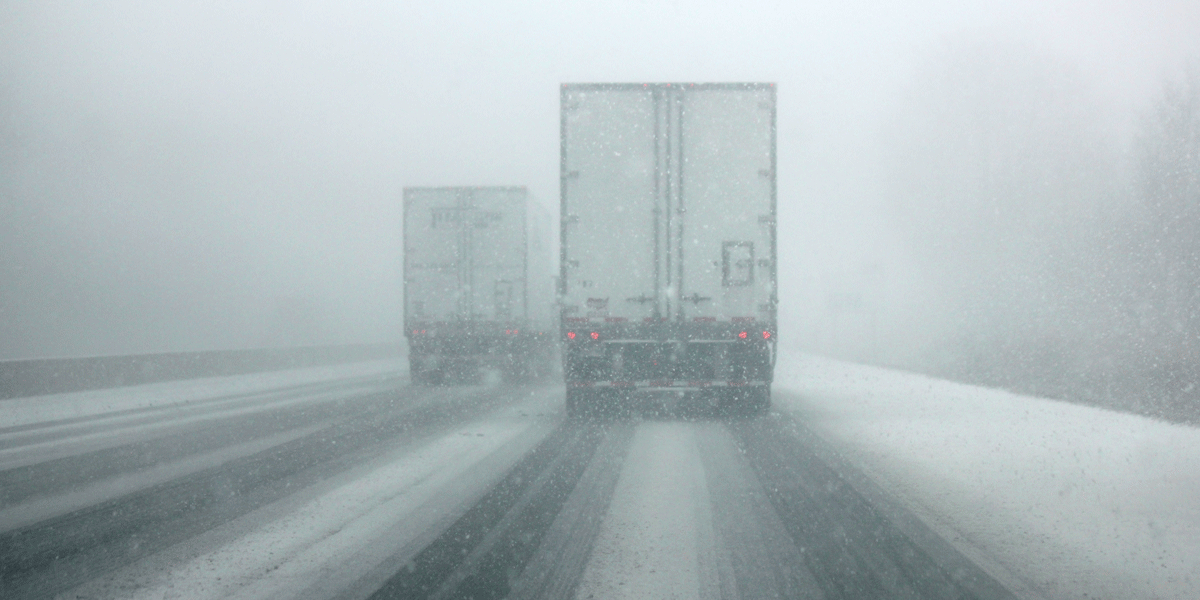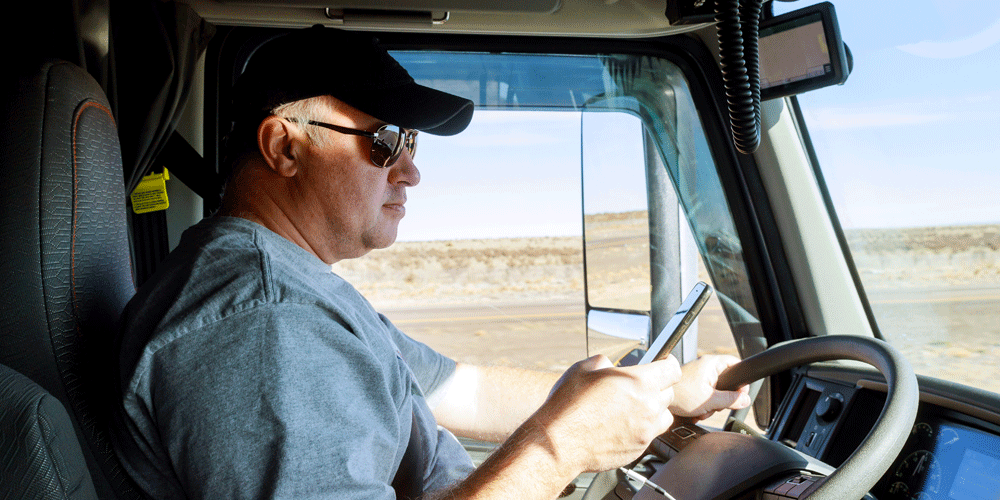Truck Driver Safe Driving Tips: 5 Accident Prevention Tips
Nathaniel Leis is the director of safety for ATS. With 16 years of experience in the transportation industry, Nathaniel has worked with Behavior Based Safety programs, OSHA compliance programs, injury prevention and management, facility safety, organizational safety, regulatory compliance with the FRA and FMCSA and operations management. Nathaniel spent the first 12 years of his career in transportation in the railroad sector managing employee safety, facility safety, environmental compliance, intermodal operations and contractor safety for BNSF railway and TTX companies. Nathaniel joined the trucking industry in 2018 with ATS where he works with the operations departments in building and sustaining safety and regulatory compliance programming for ATS and its affiliate companies.
Have you ever been in a collision? Has your semi ever jackknifed, sending you and your freight hurtling into the ditch?
It’s a scary feeling. And even if this hasn’t happened to you, you’re worried about your safety, your equipment, your freight and the motoring public around you. Maybe you’re even thinking so far ahead that repair costs and the effects on your CSA score cross your mind.
Would you believe it if I told you that the top cause of accidents according to a Federal Motor Carrier Safety Administration (FMCSA) collision study is driver error?
While you’re on the road, you have hundreds of decisions running through your mind. You’re thinking about the road in front of you, your next stop, whether or not your securements are holding. In a sea of decisions, safety best practices should be top of mind.
Then you add inclement weather to the mix. Driving in bad weather isn’t fun for any driver — for professional drivers like you and the general motoring public. Wind, snow and the threat of black ice are enough to send a wave of anxiety through even the most seasoned truck drivers.
I have nearly two decades of experience with safety in the transportation industry. I act as the director of safety at Anderson Trucking Service and I’m driven by improving the safety of our drivers out on the road.
By honing your hazard recognition skills and limiting distractions, you can help prevent accidents on the road.
After reading this, you’ll not only be refreshed on risk-reducing work practices, but you’ll feel more confident about your ability to prevent accidents.

Tip 1: Hone Your Hazard Recognition Skills
All drivers — not just professional truck drivers — get comfortable driving in certain circumstances. We all drive according to our comfort level based upon favorable past outcomes when we encountered certain hazards. And every favorable outcome reinforces our belief that the behavior is not risky, and our comfort level is justified.
For instance, let’s create a scenario using the stereotype of a teenage driver who texts while they drive. They text while driving every time they sit behind the wheel for the first two years that they have their license. They’re never caught and reprimanded and they never get into an accident, so they continue their hazardous behavior. In their third year of driving, they get into an accident because they’re texting while they drive. They total their car.
The right set of circumstances and the presence of high-risk work practices combine for collisions to occur. No matter our comfort level, we always have to drive knowing that certain conditions on the road present a specific set of hazards.
The same goes for you as a driver on the road. Maybe you are comfortable driving in rain or shine, snow or sleet. You put your truck in gear and you move on down the road. But all it takes is one spot of black ice for your tires to lose traction with the road and send your rig into the ditch.
Honing your hazard recognition skills as a driver is absolutely critical. You must implement strategies to recognize the environment you’re driving in and how specific circumstances can create hazards on the road.
One of the ways that you can recognize the environment you’re driving in is by trip planning and monitoring the weather of not just the area you’re currently in, but the areas you’ll be passing through.
You might be in Colorado in the morning with the expectation that you’ll pass through North Dakota before nightfall on your way to Minnesota. If a storm is brewing in North Dakota, you may need to pull off the road before you run through the center of the storm. Or, you will need to plan accordingly and slow your speed and increase your following distance.
Monitor the weather conditions throughout the day when you take breaks. If you can avoid poor driving conditions by parking early or taking a different route, do it. If you can’t prevent driving in poor weather conditions, implement the preventative techniques you’ve learned, like reducing your speed and increasing your following distance.
You must also consider the motoring public and their comfort level on the road. As a professional driver and one who is driving the largest vehicle on the road, you must take the most restrictive course of action. If you feel that the drivers around you are driving too slow, you either need to slow down or it’s time to pull off the road and park for the night.
Honing your hazard recognition skills is the first step in driving to protect yourself and the public on the roadways. The next step is to take actions to respond to the hazards that you identify, such as lowering your speed, maintaining a proper following distance and limiting distractions.
Tip 2: Lower Your Speed
There’s a saying here at ATS that we like to use: “Keep it 2-3 below the flow.” It means that you should always drive two to three miles per hour slower than the drivers around you.
The Federal Motor Carrier Safety Administration (FMCSA) has guidelines for driving in inclement weather. When it is raining, you should reduce your speed to one-third of the posted speed. If the speed limit is 60 MPH, you should not go above 40 MPH. You should reduce your speed by 50 percent when you’re driving in snowy conditions. For instance, if the speed limit is 60 MPH, you should drive 30 MPH or slower.
Your carrier may have other restrictions in place for driving in inclement weather. For instance, here at ATS we instruct our drivers to stay off the roads when winds are in excess of 45 MPH or visibility is less than one-eighth of a mile.
During winter weather conditions, rear-end accidents are the most frequent type of accidents. That’s because the faster you go, the more road you need in front of you to slow down. You can slide into the vehicle in front of you because you can’t stop in time.
Loss of control accidents are also common during poor winter weather conditions. When you’re going too fast for the conditions, your tires can’t maintain traction (or friction) with the road.
That isn’t to say that winter weather poses the only safety risk; rain and wind can also be dangerous. You can slide when there’s water on the road. There’s a lot of oil on the surface of roads, so roadways can be slick during rainstorms because (as we all know) oil and water don’t mix.
If you do find yourself in a skid, experience and knowledge can help get you out of it. This is when your defensive driving skills should kick in.
Remember: Don’t slam on your brakes or jerk your wheel in one direction or the other. Slamming on your brakes will only increase the rate of the slide. Don’t accelerate, either.
If you’re driving a manual, engage your clutch. If you’re driving an automatic, put the transmission in neutral. This gets the tires spinning at the same speed. Turn your wheels gently into the direction of the skid.

Tip 3: Maintain the Proper Following Distance
When road conditions are favorable, you should maintain a six-second following distance. That distance increases in the winter. Maintaining a proper following distance goes hand-in-hand with lowering your speed when the weather conditions call for it.
When you increase your following distance during bad weather, you extend your stopping distance, which is good because wet, snowy, and icy road surfaces increase the distance needed to bring your truck to a stop. Most carriers, ATS included, would rather have a late load than a driver in a collision.
You should also not pass during inclement weather, such as during snowstorms. Passing a passenger vehicle when there’s snow on the road can result in a whiteout for the vehicle’s driver. They may lose control of their vehicle, leave the roadway, and potentially collide with you.
The Smith System of Driving, which we teach here at ATS, focuses on space cushion driving. The driving techniques, when implemented, give you space and time to avoid hazards on the road.
One method of the Smith System is to aim high in your steering and look 15 seconds down the road. Looking a significant distance down the road allows you to anticipate accidents. It gives you the opportunity to react to hazards as they become apparent on the road far ahead of you, rather than when the hazard is immediately in front of you. For instance, you may have 15 seconds to react rather than one second. If you can’t see 15 seconds down the road, then you may be driving too fast for conditions.
Aiming high in your steering allows you to see the big picture, which is a big part of hazard recognition.
Give yourself space for the unexpected.
Tip 4: Limit Distractions
There are three types of distractions: physical, cognitive and visual.
- A physical distraction takes your hands off the wheel.
- Example: Eating or drinking something.
- Example: Eating or drinking something.
- A cognitive distraction is one that distracts your mind from the task of driving.
- Example: Listening to a thought-provoking podcast or engaging in a hands-free phone conversation.
- Example: Listening to a thought-provoking podcast or engaging in a hands-free phone conversation.
- A visual distraction is one that takes your eyes off the road to look at something else.
- Example: Looking at your cell phone or even looking in your mirrors too often.
Some behaviors can be a combination of distractions. For instance, texting is a physical, cognitive and visual distraction. You’re reaching for your phone, looking away from the road and thinking about the text you’re about to send.
We all want to believe that we can multitask, or perform two things at the same time. However, our brains make this impossible. We cannot perform two tasks at the same time. Our brains are actually completely switching from one task to another one, and back again while multitasking.
What we are really good at is actually switching from one task to another rapidly. This, however, is a liability to the professional truck driver, as switching from the task of driving at 65 mph means that we travel 95 feet per second while our attention is on another task.
Any time you are actively engaging your brain in something other than driving, you’re distracting yourself from the task at hand: driving.
Each distraction can be equally detrimental; all it takes is one second of distraction to cause a collision. In fact, studies have shown that certain cognitive distractions are just as distracting as physical ones. For instance, studies revealed that hands-free talking on the phone is just as distracting as holding the phone because it’s such a cognitive distraction.
You should always limit all distractions while driving. But when the driving conditions are poor, all distractions should be eliminated. That means you should avoid taking a drink of water or smoking a cigarette. You should shut off that rousing podcast. Your focus should be 100 percent on the task of driving, not on the act of reaching for your water bottle or switching the song on your phone.
If you find that you can’t focus, it’s time to get off the road and get yourself in a position where you can focus and start again. Maybe that means pulling into a rest stop to stretch and grab a snack. Maybe that means getting in a quick power nap to refresh you for the rest of your drive.
Tip 5: Drive a Truck Equipped With Accident Mitigation Technology
Accident mitigation technology works in two ways.
First, when you’re using cruise control it’ll help you maintain a proper following distance by slowing when the vehicles in front of you slow.
Second, if the system detects that the vehicle in front of you is slowing faster than you are, the system will warn you. If you do not respond appropriately, and a collision is imminent, the system activates braking.
Accident mitigation technology is great technology that can help avoid collisions and reduce the impact of collisions, sure, but it’s designed to work in optimal weather conditions.
It can’t sense bad weather or poor driving conditions, so it can’t help you keep a proper following distance in those situations. It doesn’t know when the roads are slippery, so it might not activate your brakes soon enough to prevent sliding into the vehicle in front of you.
This technology does not replace the driver or reduce your responsibility to actively manage your driving to meet the expectations of safe transportation.
Instead, rely on hazard recognition to inform your driving, which includes lowering your speed and giving yourself that space cushion on the road.
Prevent Accidents and Costly Downtime with Preventative Maintenance
Start your day being safe and end it the same way. Don’t hurry—carry a good attitude with you and keep it slow and steady on the road.
Collisions are scary. Inclement weather can be really scary. But with proven safe driving techniques in place, you don’t have to be so fearful when you get on the road. You can feel confident in your decision to pull off the road when hazards are present and you’ll know exactly how to react as conditions change.
Another cause of accidents — in addition to driver error — is poor maintenance or lack of maintenance on commercial motor vehicles. Not only can you prevent accidents by honing your hazard recognition skills, but you can also prevent accidents by following a good preventative maintenance routine. By taking care of maintenance issues and inspecting your truck at the beginning and end of your day, you can help prevent both costly downtime and unnecessary accidents due to equipment failure.
We’ve put together a list of common preventative maintenance tasks to help you stay on track with vehicle maintenance.


